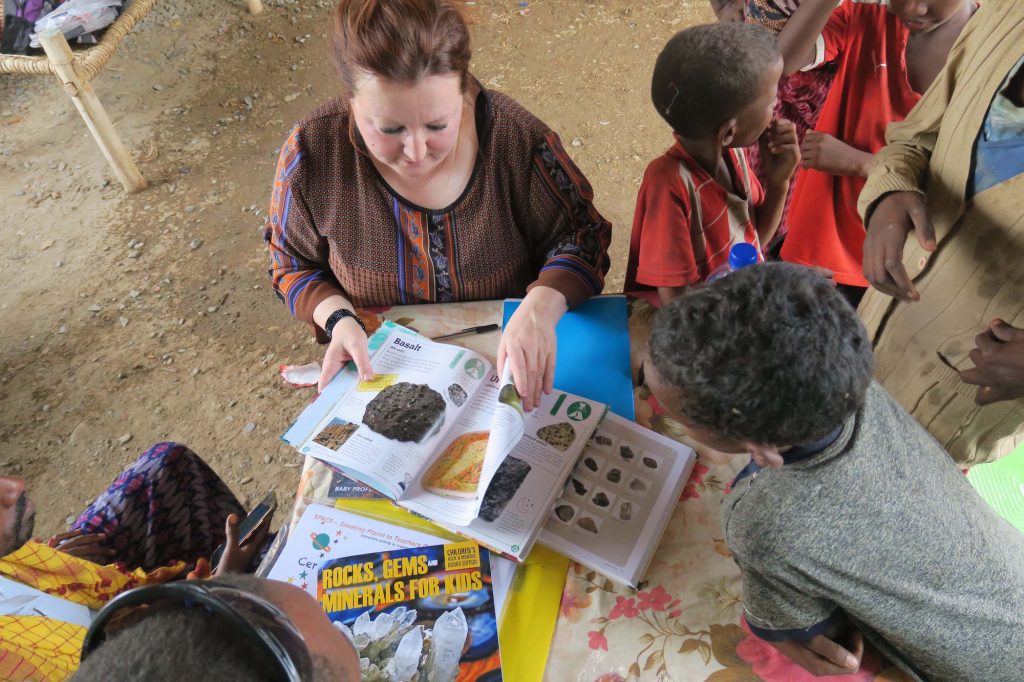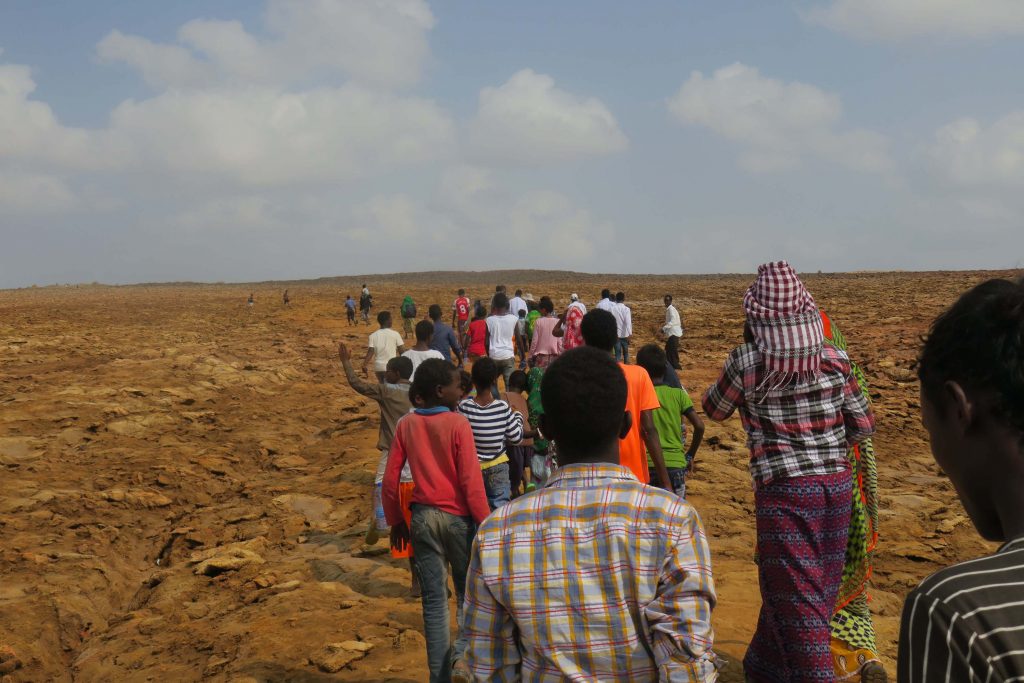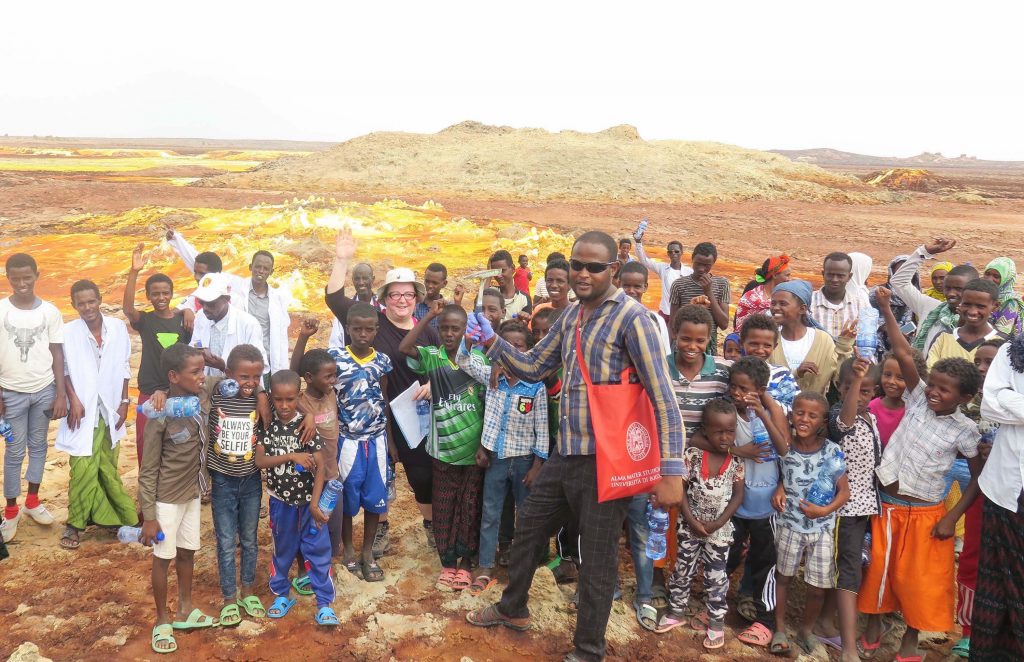From the desert of Ethiopia to other worlds
This interview by Livia Giacomini with the geologist, Barbara Cavalazzi, was first published in Italian on the MEDIA INAF site on 22 March 2019 and is reproduced with kind permission. Barbara Cavalazzi has just returned from the desert of Ethiopia for the first “Afar Desert Class”, an educational project that aims to explain to elementary school children and their teachers how to study the Earth and other planets – and the rich resources offered by our own planet.

Imagine being out in the desert of Ethiopia, talking about geology and extraterrestrial life with local children and teachers, explaining what scientists do in the field and giving the community an opportunity for growth and development… This is what Barbara Cavalazzi, a geologist from the University of Bologna, has been doing with the “Afar Desert Class”, an initiative conceived in the European project, Europlanet, in collaboration with GEMMA (Estense Mineralogical and Geological Museum of the University of Modena) and Reggio Emilia and with the support of some private associations and supporters. We met Barbara on her return from the Danakil desert, where she has just spent a couple of weeks studying and working.
Barbara, what led you from Bologna to the Ethiopian desert?
“I am a geologist and I deal with extreme environments and extremophilic life forms. I started to explore this part of the world with the University of Bologna in 2013, when no one knew about the Danakil desert as a possible terrestrial analogue for Mars. Today we know a lot more about this place, which can be considered as one of the most extreme natural places in the world with environmental temperatures easily reaching 50°C. In the middle of this salt desert rises the volcanic structure of Dallol – a salt dome about 60 meters high – formed by a phreatomagmatic eruption [an explosive eruption that results from the magma erupting through water]. On the top, there are hydrothermal sources of hot water up to 110°C, that are extremely acidic with a pH equal to 0, and with very high salinity. After several geological campaigns in these regions I came into contact with many children, who wandered around to look at my strange samples at the end of the day. I realised that despite the extreme conditions and all the difficulties, their curiosity was the same as any child’s anywhere else in the world.”
And you had an idea …
“One of the main problems with teaching local children was the language barrier. So, I thought about creating a programme with the idea of teaching teachers to reach children and offer them knowledge and opportunities. The program is called “SPACE: Speaking Planet to Teachers Community in Ethiopia”. SPACE was born in 2013 and was developed as part of the AlmaEngage project, and with support of the European planetology organisation, Europlanet 2020-RI. The objective is to work with local communities, especially in rural areas, to create opportunities, for example by creating training courses for discovering the region in respect and harmony with local communities and their culture. We focus on teacher training and the implementation of projects and courses in the school environment.”

It can’t be easy to bring elementary school children to an extreme desert environment to do lessons. Can you tell us what happened?
“This year, as part of SPACE, I led the first ‘Afar Desert Class’, a learning experience designed for elementary and middle school students of the village in this very special environment, to help them understand the uniqueness of the place where they live. The course took place from February 23rd to 25th and involved 60 children from the Hamed’Ela elementary school, their six teachers and, as often happens in Africa, the whole community of the village. The first day I taught the teachers about the geological peculiarities of their region. Obviously, the safety of children has also been a fundamental consideration, given that the places we were going to visit are extremely hot and acidic. The next day we took the children out to the field in cars. The departure from the school was unforgettable, with lots of teachers in white coats, children in single file and flags of the Afar region and Ethiopia waving us on our way. After crossing the expanse of the salt plain with our cars, we arrived at the Dallol volcano, where we got out. There, in the field, the children discovered what their region means from a scientific and geological point of view, and learned to look at their place of origin with different eyes.”
So there, in the middle of a desert, the children could see how a geologist works …
“With the help of the teachers, who acted as translators, I explained in a simple way to the children about their surroundings, the reasons for the different colours and how they were formed. For example, those hot and acid sources: why are they there, and how do we study them? Together, we collected samples and minerals, measured the pH and other simple parameters such as temperature. In short, we did everything scientists do, to understand how they do it and above all why they do it – and why it so important. In other words, we applied the basics of the scientific method for all natural sciences, starting with observation. But the idea is also to give children awareness of the uniqueness of the place in which they live, and to be proud of it and protect it from the “plasticky” pollution of tourists. The children, who have only seen the reality of the desert in their lives, were amazed to know that this is a unique place in the world, with so much potential scientifically but also touristically. There is a lot to do for the development of these countries, and we must do it one step at a time, starting with the children.”

Did you say that the experience also involved children’s families?
“Yes, that’s right: these three days have been a real event for the whole community. On the third day of our course, back at the village, we invited the families to the school. We organised a photo exhibition about the project, and the children acted as guides for their parents by telling them everything they had seen and learned. It was a real party for the whole village, with a big lunch, which the whole community will remember for a long time. Also, at the end of the course, we gave them educational materials so that they could continue the experience independently. Thanks to the organisers – but also thanks to the I Bambini del Deserto and Vivere Insieme in Pari Dignità associations, to the Istituto comprensivo Pescara 5, to Zab Tours Ethiopia and to the many friends who collaborated with me on this idea of mine – we were able to give educational resources, books and clothing to the children and the school. A little dream too… The children at the beginning of this adventure were incredulous – they could not believe that everything was being organised for them and they seemed almost scared. Then, during the three days, they loosened up, we had fun, and they learned a lot. In exchange they taught me a few words in Afar and how much can be done in developing countries, starting with the next generation. We left each other with a “See you soon!” Because yes, this has become an important part of my scientific research.

